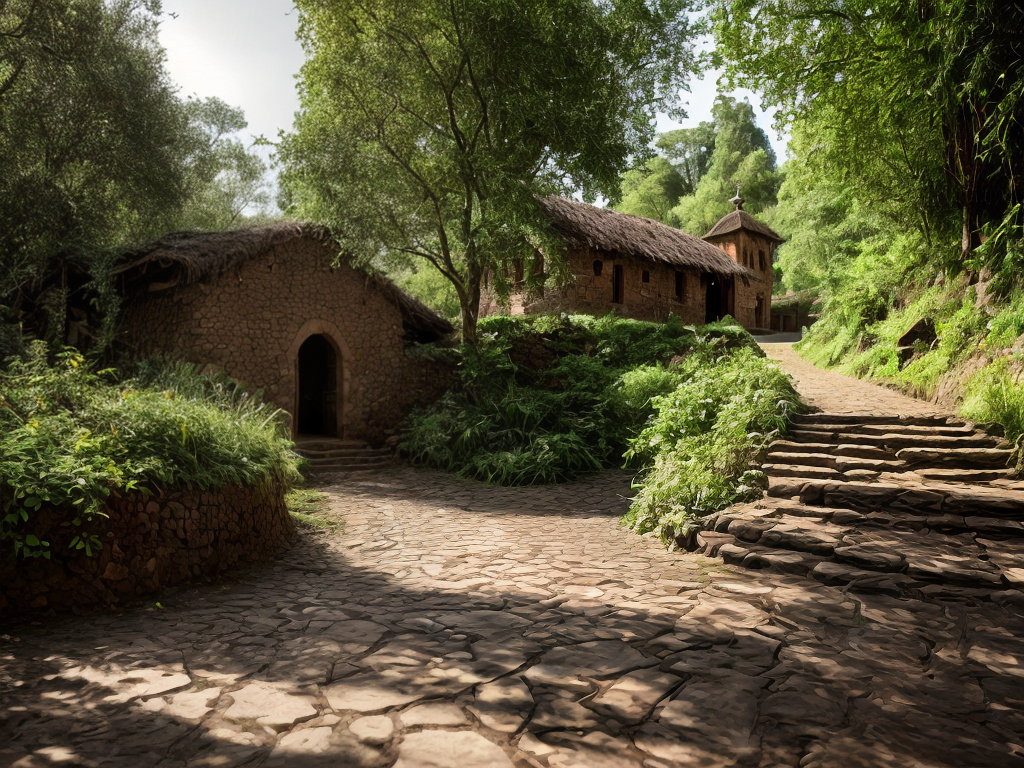As I wandered through Lalibela, I discovered a world beyond the renowned churches. Nestled among the rugged landscape, I stumbled upon hidden gems like Yemrehanna Kristos and the mystical Asheton Maryam. The Bilbala Stelae Field, with its ancient stone monuments, left me in awe. And venturing underground, I marveled at the Nakuto Le’ Abe Cave Church. Lalibela is a treasure trove of lesser-known archaeological wonders, waiting to be explored and cherished. Join me on this journey beyond churches in Lalibela.
Bet Giyorgis: The Iconic Church
Visiting Bet Giyorgis, the iconic church in Lalibela, was an awe-inspiring experience. Its iconic architecture, carved entirely out of solid rock, is a testament to the incredible craftsmanship of the medieval Ethiopian civilization. The church, dedicated to Saint George, is one of the eleven rock-hewn churches that make up the UNESCO World Heritage site in Lalibela. Its historical significance cannot be overstated, as it is believed to have been built in the 12th century by King Lalibela himself. The church’s unique design, with its cross-shaped layout and intricate carvings, showcases the rich cultural and religious heritage of Ethiopia. Exploring the interior of Bet Giyorgis, with its beautiful frescoes and ancient artifacts, transported me back in time, allowing me to appreciate the architectural marvel and historical importance of this sacred place.
Yemrehanna Kristos: A Hidden Gem
Continuing the exploration of Lalibela’s archaeological sites, one cannot overlook the hidden gem of Yemrehanna Kristos. This ancient cave church, located about 40 kilometers northeast of Lalibela, is a testament to the rich history and religious significance of the region. What makes Yemrehanna Kristos truly unique are its remarkable cave paintings and well-preserved religious artifacts. The cave paintings, dating back to the 11th century, depict scenes from the Bible and offer a glimpse into the artistic prowess of the time. Inside the church, visitors can marvel at the collection of religious artifacts, including beautifully crafted crosses, icons, and ancient manuscripts. Yemrehanna Kristos is a true treasure, showcasing the intricate blend of art, history, and spirituality that Lalibela has to offer.
Asheton Maryam: A Mountain Monastery
At Asheton Maryam, a secluded mountain monastery in Lalibela, I discovered a tranquil retreat that offers a unique spiritual experience. Nestled amidst the breathtaking landscape, this hidden gem provides a sanctuary for those seeking solace and reflection. The mountain monastery, known for its historical significance, has been a place of worship for centuries. As I made my way up the winding path, the serene atmosphere engulfed me, transporting me to a different realm. The monastery’s architecture, carved out of the rocky mountainside, is a testament to the remarkable craftsmanship of its creators. Inside, the air is thick with reverence, and the flickering candlelight adds to the ethereal ambiance. The mountain monastery of Asheton Maryam truly embodies the essence of a spiritual retreat, offering a chance to connect with oneself and find inner peace.
| Mountain Monastery | Spiritual Retreat |
|---|---|
| Asheton Maryam | Tranquil Retreat |
Bilbala Stelae Field: Ancient Stone Monuments
As I explored Lalibela further, I came across the fascinating Bilbala Stelae Field, where ancient stone monuments stand as silent witnesses to a rich and mysterious past. Here are four reasons why this site is worth exploring:
-
Ancient Burial Practices: The Bilbala Stelae Field is an extensive burial ground that dates back to ancient times. The stone monuments, known as stelae, were erected to commemorate the deceased and provide a final resting place.
-
Historical Significance: These stelae are not only significant for their role in ancient burial practices but also for the insight they provide into the history and culture of the region. They offer a glimpse into the beliefs, traditions, and social structures of the people who once inhabited Lalibela.
-
Architectural Marvels: The stelae themselves are impressive architectural structures, with intricate carvings and unique designs. Some stand tall and slender, while others are shorter and more stout. They serve as a testament to the craftsmanship and artistry of the ancient civilizations that created them.
-
Preservation Efforts: The Bilbala Stelae Field is a protected archaeological site, and efforts have been made to preserve and maintain these ancient stone monuments. Visitors can witness the ongoing restoration work and learn about the techniques used to safeguard these historical treasures for future generations.
The Bilbala Stelae Field not only showcases ancient burial practices but also holds great historical significance. Its unique architectural structures and ongoing preservation efforts make it a must-visit site for anyone interested in Lalibela’s rich past.
Nakuto Le’ Abe Cave Church: A Subterranean Wonder
I was captivated by the Nakuto Le’ Abe Cave Church, a subterranean wonder that seamlessly extends the exploration of Lalibela’s rich history beyond its churches. This unique site showcases the remarkable subterranean architecture that Lalibela is known for. The church is located inside a natural cave, and its construction involved carving directly into the rock. The intricate details and craftsmanship found within the cave are truly awe-inspiring.
But it is not just the architectural marvel that sets Nakuto Le’ Abe apart. Caves have always held a spiritual significance, and this cave church is no exception. Many people believe that caves have a natural connection to the divine. The darkness and seclusion provided by the caves create an ideal environment for meditation and prayer. The spiritual significance of this cave church adds another layer of depth to the overall experience of visiting Lalibela. It is a testament to the enduring faith and devotion of the people who built and worshipped in these subterranean sanctuaries.
Neakuto Le’ Abe Monastery: A Spiritual Retreat
Continuing our exploration beyond Lalibela’s churches, let me take you to the Neakuto Le’ Abe Monastery, a tranquil sanctuary that offers a spiritual retreat amidst the enchanting landscapes of Lalibela. This hidden gem holds great historical significance and provides a serene atmosphere for reflection and rejuvenation. Here are four reasons why this monastery is a must-visit spiritual retreat:
-
Historical Significance: Neakuto Le’ Abe Monastery is believed to have been built in the 12th century, making it one of the oldest religious sites in Lalibela. It holds a rich history and is a testament to the deep-rooted religious traditions of the region.
-
Architectural Marvel: The monastery’s unique design and intricate carvings showcase the remarkable craftsmanship of the ancient Ethiopian artisans. The stone walls, adorned with religious symbols and motifs, create a sense of awe and reverence.
-
Tranquil Environment: Nestled amidst lush greenery and breathtaking landscapes, Neakuto Le’ Abe Monastery offers a peaceful retreat away from the hustle and bustle of modern life. The serene atmosphere invites visitors to connect with their spirituality and find inner peace.
-
Cultural Immersion: Visiting this monastery provides a unique opportunity to immerse oneself in Ethiopian culture and experience the spiritual practices of the local community. Engaging with the monks and witnessing their rituals and prayers can be a deeply enriching and enlightening experience.
Neakuto Le’ Abe Monastery is not just a religious site; it is a sanctuary for the soul. Whether you seek solace, historical knowledge, or cultural immersion, this spiritual retreat in Lalibela will leave a lasting impression on your heart and mind.
Genete Mariam: The Church of Paradise
As I entered the sacred grounds of Genete Mariam, I was immediately struck by its unique architectural features, unlike any other church in Lalibela. The intricate carvings and elaborate designs spoke to the cultural significance and symbolism of this holy site. However, these ancient structures face preservation challenges, and it is important to explore the solutions that can ensure the longevity of this Church of Paradise for future generations to experience and appreciate.
Unique Architectural Features
Located in Lalibela, the Church of Paradise, also known as Genete Mariam, boasts unique architectural features that set it apart from other churches in the area. Its distinct design and historical significance make it a must-visit for anyone interested in ancient Ethiopian architecture. Here are four remarkable features that make the Church of Paradise truly exceptional:
-
Rock-hewn structure: Like other churches in Lalibela, Genete Mariam is carved out of solid rock. However, what sets it apart is its intricate design, with multiple levels and intricate carvings that showcase the skill and artistry of the craftsmen who built it.
-
Elaborate frescoes: The interior of the church is adorned with vibrant frescoes depicting biblical scenes and figures. These colorful paintings not only add to the beauty of the church but also provide valuable insights into Ethiopian religious art.
-
Unique cruciform shape: Unlike the traditional rectangular shape of most churches, Genete Mariam is built in the shape of a cross. This architectural choice symbolizes the crucifixion of Jesus Christ and adds to the spiritual significance of the church.
-
Underground tunnels: The Church of Paradise is connected to other churches in Lalibela through a network of underground tunnels. These tunnels served as passageways for priests and pilgrims, providing them with a safe and private route to move between the churches.
These unique architectural features make Genete Mariam a fascinating destination for history enthusiasts and architectural aficionados alike.
Cultural Significance and Symbolism
The cultural significance and symbolism of Genete Mariam, also known as the Church of Paradise, can be explored through its rich history and architectural elements. This ancient Ethiopian Orthodox church holds immense historical significance, as it is believed to have been built during the reign of King Lalibela in the 12th century. The church is a testament to the cultural practices and religious fervor of the time, showcasing intricate carvings and artwork that depict biblical scenes and saints. The architecture itself is symbolic, with its underground design representing the journey to paradise. The church is also a pilgrimage site for many Ethiopian Orthodox Christians, who visit to partake in religious ceremonies and seek spiritual solace. The historical significance and cultural practices associated with Genete Mariam make it a truly remarkable archaeological site in Lalibela.
Preservation Challenges and Solutions
Preserving Genete Mariam, the Church of Paradise, presents unique challenges that require innovative solutions. As we strive to protect this remarkable heritage site, we encounter various preservation challenges that demand careful consideration and action. Here are four key challenges we face in the preservation of Genete Mariam, along with potential solutions:
-
Structural degradation: The church’s ancient stone walls are susceptible to erosion and weathering. Regular maintenance and repair can prevent further damage.
-
Environmental threats: Natural elements like humidity, rainfall, and temperature fluctuations pose risks to the church’s fragile structure. Installing climate control systems can help regulate the environment and mitigate potential harm.
-
Tourism impact: Increased tourism can lead to overcrowding and wear and tear on the site. Implementing visitor management strategies, such as limiting the number of visitors and creating designated paths, can help preserve the church while still allowing access.
-
Lack of funding: Adequate financial resources are crucial for the proper preservation of Genete Mariam. Seeking funding through grants, partnerships, and public campaigns can secure the necessary funds for ongoing maintenance and conservation efforts.
Lalibela Museum: Preserving the Past
While exploring the lesser-known archaeological sites in Lalibela, I discovered the remarkable preservation efforts at the Lalibela Museum. This museum is dedicated to safeguarding the historical artifacts and cultural heritage of the region. It plays a crucial role in preserving the past for future generations to appreciate and learn from.
The Lalibela Museum houses a vast collection of artifacts that provide valuable insights into the rich history and cultural traditions of Lalibela. From ancient manuscripts and religious icons to traditional handicrafts and archaeological findings, the museum offers a glimpse into the vibrant heritage of the region.
To give you a better idea, here’s a table showcasing some of the notable artifacts found in the Lalibela Museum:
| Artifact | Description | Significance |
|---|---|---|
| Ancient Manuscripts | Handwritten religious texts | Provide insights into religious practices |
| Religious Icons | Sacred images of saints and biblical figures | Represent spiritual devotion |
| Traditional Handicrafts | Intricately crafted objects | Reflect local artistic traditions |
The Lalibela Museum’s commitment to cultural heritage preservation is commendable. Through their efforts, they are not only safeguarding the past but also promoting a deeper understanding and appreciation of Lalibela’s history and culture.







